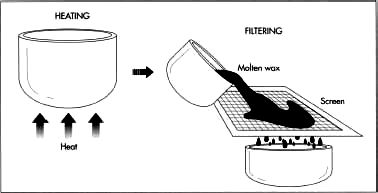Among the earliest types of portable illumination, candle lights have offered
vital functions for humankind throughout history, a well known fact chronicled
with the discovery of candle lights or candle-like objects in just about any
society. Historians believe the initial candle might have been introduced by
primitive men that dipped dried branches in animal fat, thus creating a
slow-burning and reliable light. Reliefs of the
ancient Egyptians illustrate using candle lights by authors and philosophers
who labored well after sundown. These early candle lights were probably
developed from tapers which were made from " floating " fibrous materials combined with wax
or tallow (the white-colored, nearly tasteless fat of cattle or sheep which was
also accustomed to make soap, margarine, and lubricants). Dating back to 3000
B.C.
, dish-formed candle lights were utilised around the island of The island.

Candle lights are also employed for religious purposes. The Bible, for
instance, makes numerous references to using candle lights, such as the
story of King Solomon who, after building the Temple, used ten
candle-stays with light the south and north ends from the structure. Within the
Dark Ages, candlemaking grew to become a well known occupation, as evidenced through the
development of many candlemakers' guilds throughout Europe. Later,
candle lights were utilised as a way of keeping time. At auctions, the putting in a bid
there was a time restricted to inserting a pin right into a candle and letting the wax melt
before the pin dropped, thus concluding that time period.
Even though the materials define a candle have altered with the
years, the skill of candlemaking has continued to be surprisingly like the
original production processes. Candle wicks were, initially, made from reeds
or rushes eventually, various natural fibers were utilised. In 1824,
Frenchman Jean-Jacques Cambaraceres introduced an essential refinement in
wick technology using the plaited wick, which burned more evenly than
unplaited wicks. Twisted or plaited cotton still comprises most wicks
today.
Animal or vegetable fats were utilised for that first candle lights. As candlemaking
technology progressed, beeswax grew to become broadly used, mainly due to its
pleasing odor and the lack of the mess that melting fats created.
Following the Revolutionary War, the whaling industry in the usa skyrocketed.
However, its not all kind of whale was valued exclusively because of its blubber. The
sperm whale seemed to be employed for its spermaceti—the wax obtained from the
oil of the huge mammal. This wax was utilized extensively because the fishing
industry started to grow. The spermaceti candle was popular since it had
no acrid odor, didn’t soften in summer time temperatures, and burned evenly.
Ozokerite, a without color mineral hydrocarbon wax having a high melting point,
seemed to be famous the seventeenth and eighteenth centuries. As candle
technology advanced, animal fats were separated, departing behind more
desirable solid essential fatty acids for example stearine which had no odor and gave a
better light. Paraffin, a wax crystallized from oil, grew to become
popular throughout the 1860s and it was eventually combined with spermaceti and
ceresin𠅊 consequence of refined oil oil—to produce a
stronger wax.
The initial candle lights were created with the dipping method. Dating back to
towards the Dark Ages, this process used wicks made
Resourse: http://madehow.com/Volume-1/
How to Make Candles : Materials, Supplies & Tools Needed for Candle Making
COMMENTS:
Bernadette Naborte: where to find the materials for candle making? i need to know ASAP, thanks
Michael Elrod: Nice
theMusicFairy1: really are all those materials really needed\n
Crazyaz05: please number the videos. to make it a little easier on how to start to finish a project.
Shaarme00: okay, then… where is the explanation about HOW TO make the candles after introducing the materials?
Marios Gregoriou: can i somehow use paraffin oil to make the candles?
Barb Chester: If your glass container candles are pulling away from the inside of the glass it's most likely you are using too much stearin or the candle is cooling too quickly, there can be lots of reasons but my guess would be one of those two. Stearin is a hardner and adds opacity to the base wax so try a bit less stearin and see if it improves.
Barb Chester: If you want to know how many votives you can get from a pound of beeswax, fill your votive with water to the level you want then measure that amt of water and the it's easy to figure how many votives you can get with a lb of beeswax.
Barb Chester: Yaley makes what I think are the best solid scents, as far as liquid scents I have found them to all be very similiar, you have to be a bit more careful with liquid scents regarding amt of scent to wax as they can cause the wax to separate and give an oily appearance to the candle or candle won't burn properly. Also, that aluminum pot he showed is a pouring pot not a melting pot, you need a double boiler for melting wax.
Barb Chester: This guy owns a candle making company??? Yikes…he just gave so much wrong info and left out alot of important things too..oh well if you are new to candle making do your research.
nulsof –: My candle won't stick inside the glass after it turns solid.\nI'm using Stearic acid (or stearin).\nAny idea how to make it stick inside the glass?
Bharat lal: nulsof – bharat bhargaw
Bharat lal: nulsof – bharat bhargaw Rawmateriyal kaha milega mombattiy
WonderWomanFan4life: SWEEEET. thanks bro